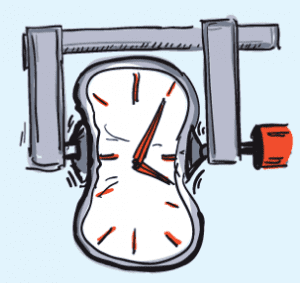 There’s a lot being talked about these days about the concept of high reliability organizations. The concept is being embraced by many hospitals throughout the United States and, arguably, for good reason. The principles of highly reliable organizations have direct application to first responders. This contribution focuses on helping you understand the overarching concept of what a high reliability organization is and how the principles might apply to us.
There’s a lot being talked about these days about the concept of high reliability organizations. The concept is being embraced by many hospitals throughout the United States and, arguably, for good reason. The principles of highly reliable organizations have direct application to first responders. This contribution focuses on helping you understand the overarching concept of what a high reliability organization is and how the principles might apply to us.
 High reliability organizations (HROs)
High reliability organizations (HROs)
HROs are entities that have developed and implemented systems that provide extraordinary consistent and extremely effective and predictable results. These successful systems help HROs avoid errors that could prove to be catastrophic. Early adopters of HRO philosophies were domains whose past failures had extremely catastrophic consequences (e.g., commercial airplane crashes and nuclear reactor meltdowns). Safety managers in aviation and nuclear power realized they needed to identify the weak danger signals present and take action to address the dangers and keep the system functioning and avoid a disaster.
A common thread
The organizations who adopt HRO practices change the way they respond to threats. As researchers who’ve studied these organizations note, some common threads have emerged. Let’s examine some of the themes.
Complexity
 HROs are often very complex organizations where members work in complex environments. The environment is often one dependent on multiple teams coordinating their activities to ensure safety. The safety of firefighters operating on emergency scenes requires the coordination of dispatchers, commanders, safety officers, division leaders, attack crews, search crews, vent crews, and pump operators. The coordination often involves other outside agencies as well (e.g., police, EMS, utility company, social services, Red Cross). Hypercomplexity is present in airlines, nuclear energy and in the fire service.
HROs are often very complex organizations where members work in complex environments. The environment is often one dependent on multiple teams coordinating their activities to ensure safety. The safety of firefighters operating on emergency scenes requires the coordination of dispatchers, commanders, safety officers, division leaders, attack crews, search crews, vent crews, and pump operators. The coordination often involves other outside agencies as well (e.g., police, EMS, utility company, social services, Red Cross). Hypercomplexity is present in airlines, nuclear energy and in the fire service.
Teamwork
 HROs consist of tightly connected teams in which team members often depend on tasks performed by members of other teams. Safe operations at a structure fire depends on the coordinated efforts of multiple teams of responders to ensure the fire is ventilated and extinguished, victims are located and rescued, property is conserved and firefighter safety is ensured throughout. Many fire service leaders realize the coordination of firefighting teams is essential. Most also acknowledge the coordination has room for improvement.
HROs consist of tightly connected teams in which team members often depend on tasks performed by members of other teams. Safe operations at a structure fire depends on the coordinated efforts of multiple teams of responders to ensure the fire is ventilated and extinguished, victims are located and rescued, property is conserved and firefighter safety is ensured throughout. Many fire service leaders realize the coordination of firefighting teams is essential. Most also acknowledge the coordination has room for improvement.
Knowledge supersedes rank
 In HROs, roles and responsibilities are clearly differentiated and defined. The complexity of the hierarchy requires a lot of effort to ensure the teams are coordinated and the cross functional team members work well together. One of the ways that HROs differ in philosophy from the traditional fire department organizational hierarchy is that during times of crisis critical decisions are not made by the ranking commander or senior administrator. Rather, critical decisions are deferred to the most knowledgeable person on the team, regardless of their rank in the organization.
In HROs, roles and responsibilities are clearly differentiated and defined. The complexity of the hierarchy requires a lot of effort to ensure the teams are coordinated and the cross functional team members work well together. One of the ways that HROs differ in philosophy from the traditional fire department organizational hierarchy is that during times of crisis critical decisions are not made by the ranking commander or senior administrator. Rather, critical decisions are deferred to the most knowledgeable person on the team, regardless of their rank in the organization.
In an HRO there are many individuals making decisions. Many of those decisions are interconnected with the decisions being made by others. Cross communications becomes critical to ensure safety. HROs have processes in place that ensure the decision makers can communicate essential information in timely ways.
Accountability
 Because of the nature of the business most HROs are engaged in, when errors do occur the consequences are often severe and involve injuries, death, environmental catastrophe and massive financial losses. Thus, accountability is a critical component of HROs. In the context of response to fires, not all victims are savable. Sometimes the outcomes are scripted long before the fire department arrives. In some cases, the outcome may be certain before the fire department is even notified for the call. This is where the role of prevention is intertwined with response in the creation of a fire service HRO – identifying the potential failures in advance of an emergency response and working to get them fixed – often with cross functional teams from multiple agencies.
Because of the nature of the business most HROs are engaged in, when errors do occur the consequences are often severe and involve injuries, death, environmental catastrophe and massive financial losses. Thus, accountability is a critical component of HROs. In the context of response to fires, not all victims are savable. Sometimes the outcomes are scripted long before the fire department arrives. In some cases, the outcome may be certain before the fire department is even notified for the call. This is where the role of prevention is intertwined with response in the creation of a fire service HRO – identifying the potential failures in advance of an emergency response and working to get them fixed – often with cross functional teams from multiple agencies.
Feedback
 It is a hallmark of HROs that team members give and receive feedback all the time. Constant feedback creates an opportunity for team members to continually adjust their actions and improve their ability to anticipate problems and avoid problems before they turn into a crises. In the fire service, feedback can come in many ways. It’s not simply the quantity of feedback but also the quality of the feedback. Massive amounts of information may actually be harmful to resiliency because team members have to sift through all the data to determine what is important and what is not. The goal in an HRO is to ensure systems – and mindsets – are in place to ensure team members get the right feedback, in the right quantity, at the right time to improve decision making.
It is a hallmark of HROs that team members give and receive feedback all the time. Constant feedback creates an opportunity for team members to continually adjust their actions and improve their ability to anticipate problems and avoid problems before they turn into a crises. In the fire service, feedback can come in many ways. It’s not simply the quantity of feedback but also the quality of the feedback. Massive amounts of information may actually be harmful to resiliency because team members have to sift through all the data to determine what is important and what is not. The goal in an HRO is to ensure systems – and mindsets – are in place to ensure team members get the right feedback, in the right quantity, at the right time to improve decision making.
Compressed time constraints
 Time constraints are common to many industries, including the fire service. In HROs, there is a design in their systems and a mindset in their culture that allows team members to identify and communicate when they do not have the time to thoroughly and accurately complete all their tasks. The system facilitates a team member’s ability to ask for and receive assistance. Fire department personnel often face challenges where personnel are asked to do more with less and complete tasks without the proper staffing and resources. The time constraints of an emergency scene, hampered by staffing shortages can certainly strain the system and, not surprising, is often a contributing factor to casualties.
Time constraints are common to many industries, including the fire service. In HROs, there is a design in their systems and a mindset in their culture that allows team members to identify and communicate when they do not have the time to thoroughly and accurately complete all their tasks. The system facilitates a team member’s ability to ask for and receive assistance. Fire department personnel often face challenges where personnel are asked to do more with less and complete tasks without the proper staffing and resources. The time constraints of an emergency scene, hampered by staffing shortages can certainly strain the system and, not surprising, is often a contributing factor to casualties.
Chief Gasaway’s Advice
 There are many lessons the fire service can learn from HROs. It starts with obtaining some baseline training on the concepts of what it means to be a highly reliable organization. To embrace the concept means fundamentally changing how many departments look at how they provide service. To become an HRO takes effort, commitment and buy-in from top to bottom. It’s not enough to embrace a few buzzwords – like saying “We practice mindfulness in our organization” – which is something I was told once to which I asked what that meant and got an answer that made it clear they had no idea what they were talking about… but it sounded good when they said it.
There are many lessons the fire service can learn from HROs. It starts with obtaining some baseline training on the concepts of what it means to be a highly reliable organization. To embrace the concept means fundamentally changing how many departments look at how they provide service. To become an HRO takes effort, commitment and buy-in from top to bottom. It’s not enough to embrace a few buzzwords – like saying “We practice mindfulness in our organization” – which is something I was told once to which I asked what that meant and got an answer that made it clear they had no idea what they were talking about… but it sounded good when they said it.
The fire service can learn a lot from other domains where high risk, high consequence decisions are a matter of business (i.e., aviation, medicine, military, nuclear energy). Become a student of the best practices being used in those industries to improve safety. We cannot become all that we are capable of by remaining what we are. It’s time to open ourselves to new ways of doing business, especially when it results in improving safety to our members.
There are many resources and classes available to teach the concepts of highly reliable organizations. I have listed a few at the end of this article. If I can be of assistance to you in providing additional resources or providing a program for your members, please let me know.
1. Discuss what systems and practices your department has in place to ensure outcomes are predictable and successful.
2. Discuss how communications facilitates or hampers your department’s ability to provide highly reliable outcomes.
3. Discuss your department’s system for providing feedback that ensures all team members are well-informed on the most important information needed to make quality decisions.
Additional resources
Baker, D.P., Day, R., & Salas, E. (2006). Teamwork as an essential component of high-reliability organizations. Health Serv Res. Aug;41(4 Pt 2):1576-98.
McKeon, L.M., Oswaks, J.D., & Cunningham P.D. (2006). Safeguarding patients: complexity science, high reliability organizations, and implications for team training in healthcare. Clin Nurse Spec. Nov-Dec;20(6):298-304; quiz 305-6.
Roberts, K.H. & Rousseau, D,M. (1989). Research in nearly failure-free, high-reliability organizations: having the bubble. IEEE Trans Engin Manage. May 36(2):132-9.
Weick, K.E., & Sutcliffe, K.M.(2001). Managing the unexpected: assuring high performance in an age of complexity. San Francisco: Jossey-Bass.
___________________________________________________________
The mission of Situational Awareness Matters is simple: Help first responders see the bad things coming… in time to change the outcome.
Safety begins with SA!
___________________________________________________________
Post your answers to the discussion questions or your comments to this article in the “Leave a Reply” box below.
If you want to send me incident pictures, videos or have an idea you’d like me to research and write about, contact me. I really enjoy getting feedback and supportive messages from fellow first responders. It gives me the energy to work harder for you.
Thanks,
Email: Support@RichGasaway.com
Phone: 612-548-4424
Facebook Page: www.facebook.com/SAMatters
LinkedIn: Rich Gasaway
Twitter: @RichGasaway
YouTube: SAMattersTV
iTunes: SAMatters



